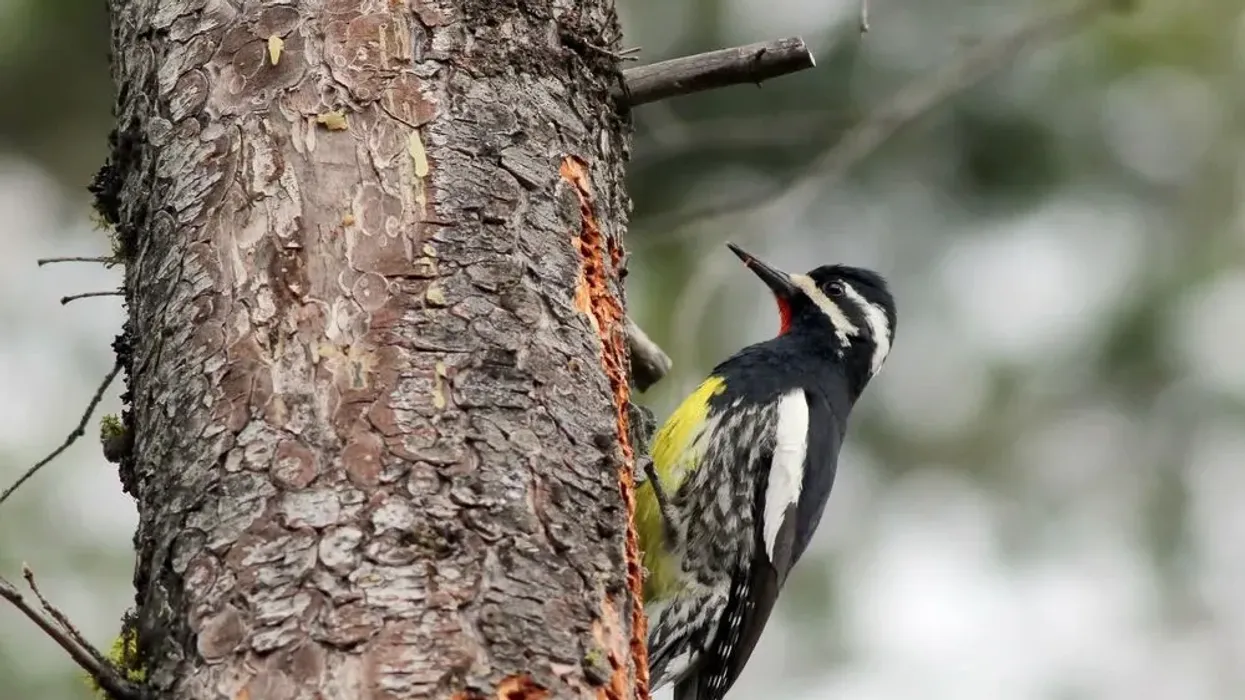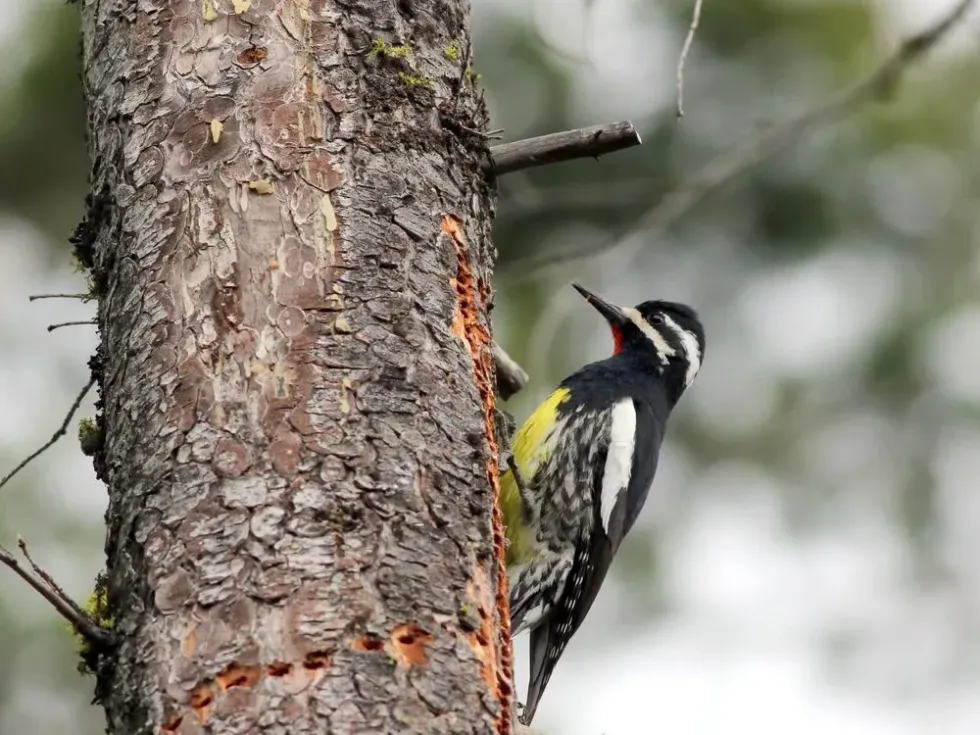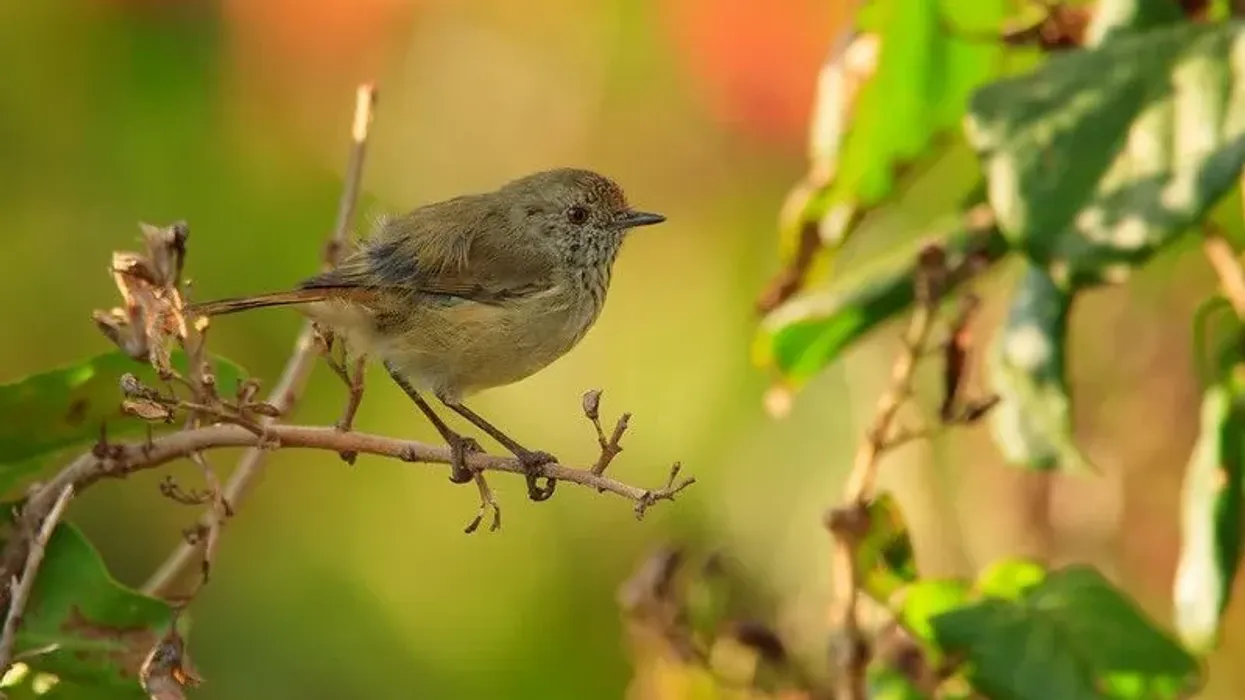The Williamson's sapsucker (Sphyrapicus thyroideus) is a medium-sized sapsucker of the family Picidae. Females and males are sexually dimorphic with iridescent black, yellow, brown, and white colors.
Two subspecies of Williamson's sapsucker are Sphyrapicus thyroideus thyroideus (Cassin, 1852) and Sphyrapicus thyroideus nataliae (Malherbe, 1854). The males and females of this species were considered different species in the 19th century.
The females were first described as Picus thyroideus in 1852 and males as Picus williamsonii in 1857. The genus name Sphyrapicus was allocated by Baird for both sexes in 1858.
The common name Williamson comes from the leader of the surveying expedition that discovered the first male, Lieutenant Robert Stockton Williamson. The Sphyrapicus or sapsucker genus was introduced by Spencer Baird, an American naturalist, in 1858, with type species as yellow-bellied sapsucker ( Sphyrapicus varius).
There are two Ancient Greek elements in Sphyrapicus, 'sphura', meaning 'hammer' and 'pikos', meaning 'woodpecker'.
There are four described species within this genus. This species belongs to the tribe Melanarpini within the subfamily Picinae.
There are five tribes in Picinae. There are 238 woodpeckers within 36 genera in the world.
If you enjoyed reading these facts about Williamson's sapsucker, then make sure to read about the flycatcher and blackpoll warbler on Kidadl.
Williamson's Sapsucker Interesting Facts
What type of animal is the Williamson's sapsucker?
The Williamson's sapsucker (Sphyrapicus thyroideus) is a woodpecker of the order Piciformes and phylum Chordata. This North American bird is partly migratory but is mostly a resident bird in its habitat range. When they do migrate, migration occurs in small groups.
The bird drills sap wells around trees that are neatly spaced to search and feed on sap periodically. Males get very territorial during the breeding season. This bird does not maintain territories in the winter.
What class of animal does the Williamson's sapsucker belong to?
The Williamson's sapsuckers belong to the class of Aves of animals.
How many Williamson's sapsuckers are there in the world?
The population of Williamson's sapsuckers in the world has not yet been evaluated. However, the estimated population in Canada is around 430 breeding adults divided into five populations.
Where does a Williamson's sapsucker live?
The breeding range of Williamson's sapsuckers includes habitats in western North America, extending from northern America to the north in British Columbia. As they are partly migratory, these birds also travel far south to a range of habitats in central Mexico.
What is a Williamson's sapsucker's habitat?
These woodpeckers occupy a breeding range in aspen and coniferous forests primarily with Douglas fir, grand fir, and ponderosa pine and mountains. Some other trees in the range of habitats preferred by this species are western larch and Subalpine fir.
They fly down to lower elevations during migration in winter and also around riparian forests, pinyon pine-juniper, and oak scrub.
Who do Williamson's sapsuckers live with?
These sapsucker woodpeckers either live in flocks or pairs.
How long does a Williamson's sapsucker live?
These sapsucker woodpeckers live for four years.
How do they reproduce?
The adult male and female pair up during the breeding season and build a new nest by excavating a cavity in live trees. These birds choose a habitat around aspen and coniferous fungal infected trees as the wood gets soft and they also choose large, old trees.
The woodpecker bird lines the cavity with wood chips. The cavity is 10.5 in (26.67 cm) deep and 3.6 in (9.1 cm) and the holes are 1.6 in (4 cm) in diameter. These birds excavate new cavity each year.
The female birds lay four to six glossy white eggs. The male and female woodpecker birds incubate these eggs for 10-13 days.
The eggs are incubated by these North American sapsuckers at night and at some points in the day. Juveniles are born naked, closed-eyed, and helpless. Adult birds also split the responsibilities of cleaning up fecal matter and feeding.
The adults feed insects like ants to the young ones. After three to four weeks of hatching, these young birds leave the nests around mid-June or mid-July.
What is their conservation status?
The conservation status of these sapsuckers is evaluated as Least Concern. The conservation of this species is currently not needed as they are quite common in their natural habitat. However, they do face threats like winter habitat loss and climate change.
Williamson's Sapsucker Fun Facts
What do Williamson's sapsuckers look like?
These woodpeckers are medium-sized birds with a medium-sized bill, fairly long wings, and stout compact bodies. The female and male species have such varying colors that they were previously considered different species.
Male woodpeckers have iridescent black on their sides, tail, head, and back with two white stripes on their face on the side of their head and vertical black and white wing patch. The males have black and white rump with red-throat and yellow-belly.
Adult female woodpeckers have black and white bands overall with black breast, brown head, yellow belly, white bands on their back tails, and whitish rump. The female lacks white patches on their wings, unlike the males. The juveniles in this bird species are quite similar to the adult birds but are duller and lack the red-throat.
How cute are they?
These birds of western North America are medium-sized with varying coloration and they are considered cute.
How do they communicate?
These birds of North America communicate using vocals like calls and drumming, body language, and sounds to communicate. They drum on trees to establish territories. Although both sexes drum, males do it frequently and louder. As this species are not songbirds, they produce typical calls than songs. These woodpeckers give out calls like high-nasal 'chyaah', staccato, and rattling trills.
How big is a Williamson's sapsucker?
These woodpeckers are 8.3-9.8 in (21-25 cm) in length with a wing-span around 17 in (43 cm). These birds are almost the same size as Gila woodpeckers. Also, this species is smaller than northern flickers, but larger than downy woodpeckers.
How fast can a Williamson's sapsucker fly?
The exact flight speed of this bird species is not known.
How much does a Williamson's sapsucker weigh?
This bird species weighs around 0.09-0.12 lb (44-55 g).
What are the male and female names of the species?
There is no specific name given to male and female Williamson's sapsuckers.
What would you call a baby Williamson's sapsucker?
There is no specific name given to a juvenile male Williamson's sapsucker bird or a juvenile female Williamson's sapsucker bird.
What do they eat?
This species feeds mostly on insects but these birds also feed a lot on sap from Pholem, the innermost part of moist bark that produces sap, and coniferous trees. This species drills holes or sap wells around the trees to harvest the sap.
As they get ready for breeding and brooding in spring, they frequently feed on the sap. The young ones are heavily fed insects usually ants, but also aphids, beetles, and flies. They search and pick ants or other insects from branches of a tree or even on ground.
They also catch insects mid-air. Some of the insects they feed on are click beetles, ground beetles, carpenter ants, rove beetles, and crane flies.
Are they dangerous?
No, this species is not dangerous to humans.
Would they make a good pet?
No, these birds would not make good pets. They thrive around forests with conifers.
Did you know...
Previously, females were named black-breasted sapsuckers, referring to the patch present on their breast.
Sapsuckers can kill trees in your garden because these birds dig into the bark of the tree and stops the flow of sap to the roots. Sapsuckers prefer trees with a high sugar content such as birch and maple trees.
How did Williamson's sapsuckers get their name?
Williamson's sapsuckers of the family Picidae got their common name Williamson from the leader of the surveying expedition that discovered the first male, Lieutenant Robert Stockton Williamson.
What is the difference between a sapsucker and a woodpecker?
Both woodpeckers and sapsuckers are of the same family. Woodpeckers prefer all kinds of drying and dead trees but sapsuckers prefer oaks and maples. Sapsuckers create holes in a horizontal line whereas woodpeckers create large holes at random on a tree. Sapsuckers are part of the woodpecker species.
Here at Kidadl, we have carefully created lots of interesting family-friendly animal facts for everyone to discover! For more relatable content, check out these Anna's hummingbird facts and Ani bird facts for kids.
You can even occupy yourself at home by coloring in one of our free printable woodpecker coloring pages.









